Abstract
The relationship between physical activity and risk of symptomatic diverticular disease has not been investigated directly. This association was examined in a prospective cohort of 47,678 American men, 40 to 75 years of age, and free of diagnosed diverticular disease, colon or rectal polyp, ulcerative colitis, and cancer before 1988. During four years of follow up, 382 newly diagnosed cases of symptomatic diverticular disease were documented. After adjustment for age, energy adjusted dietary fibre, and energy adjusted total fat, overall physical activity was inversely associated with the risk of symptomatic diverticular disease (for highest versus lowest extremes, relative risk (RR) = 0.63 (95% confidence interval (CI) 0.45, 0.88). Most of the inverse association was attributable to vigorous activity, for extreme categories RR = 0.60 (95% CI 0.41, 0.87). For activity that was not vigorous the RR was 0.93 (95% CI 0.67, 1.69). Several specific activities were inversely associated with the risk of diverticular disease, but jogging and running combined was the only individual activity that was statistically significant (p for trend = 0.03). For men in the lowest quintile for dietary fibre intake and total physical activity (compared with those in the opposite extreme), the RR was 2.56 (95% CI 1.36, 4.82). Physical activity, along with a high fibre diet, may be an important factor in the prevention of symptomatic diverticular disease.
Full text
PDF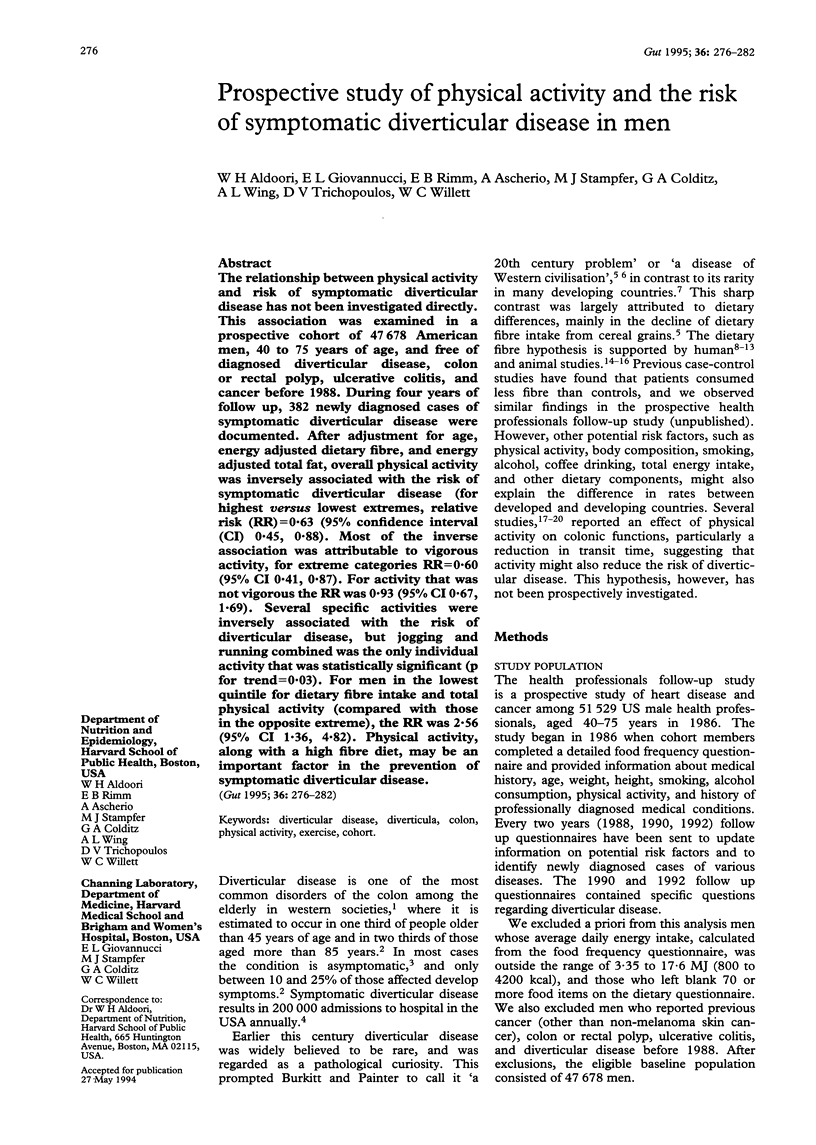
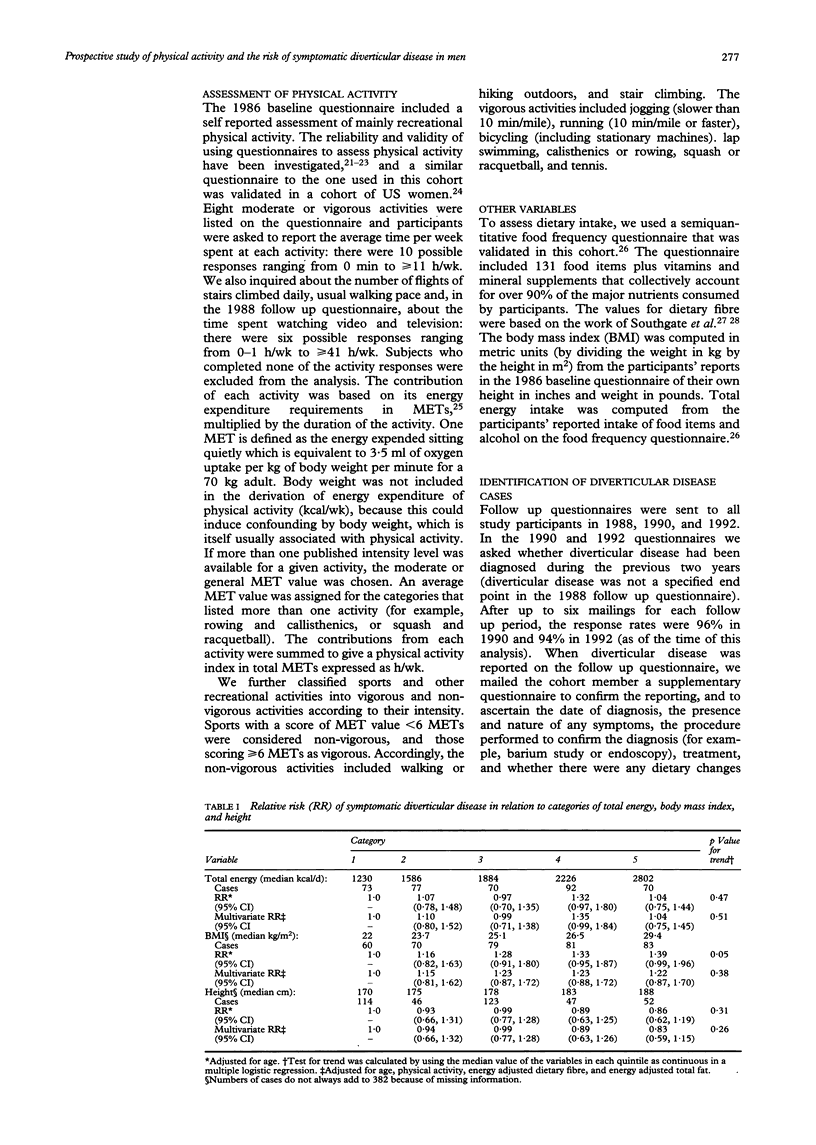
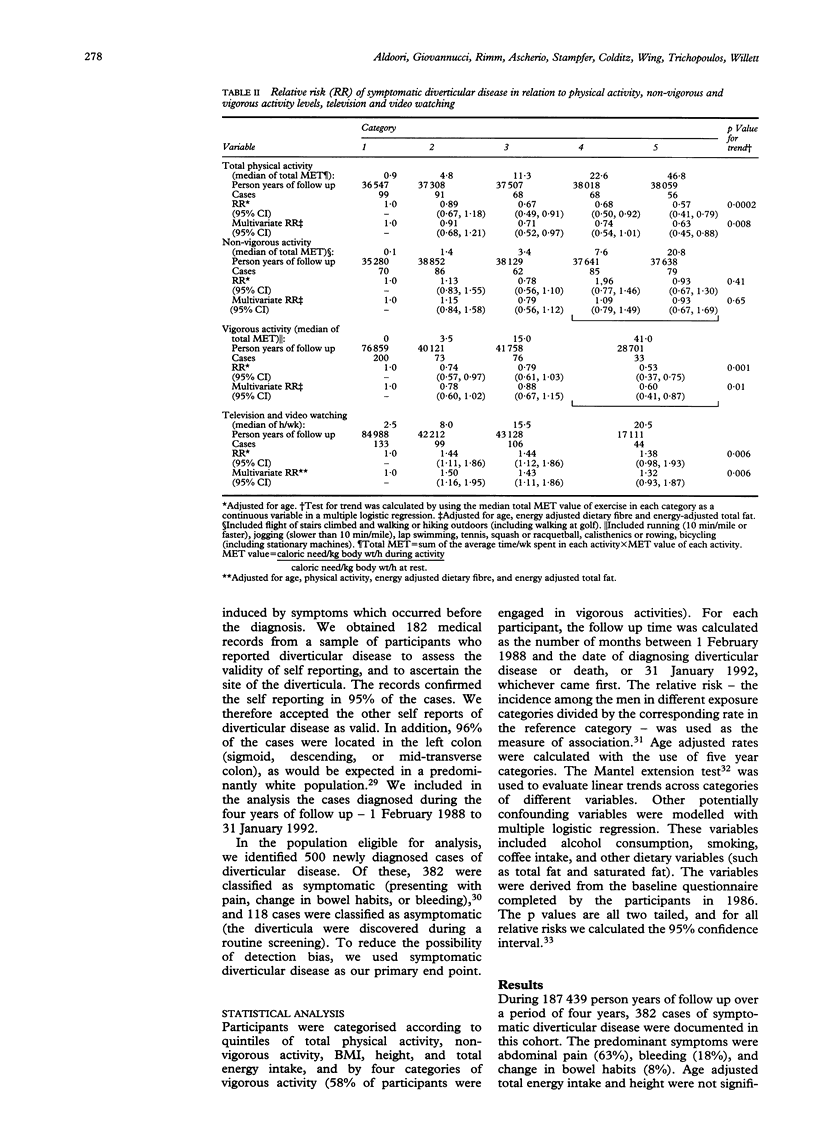

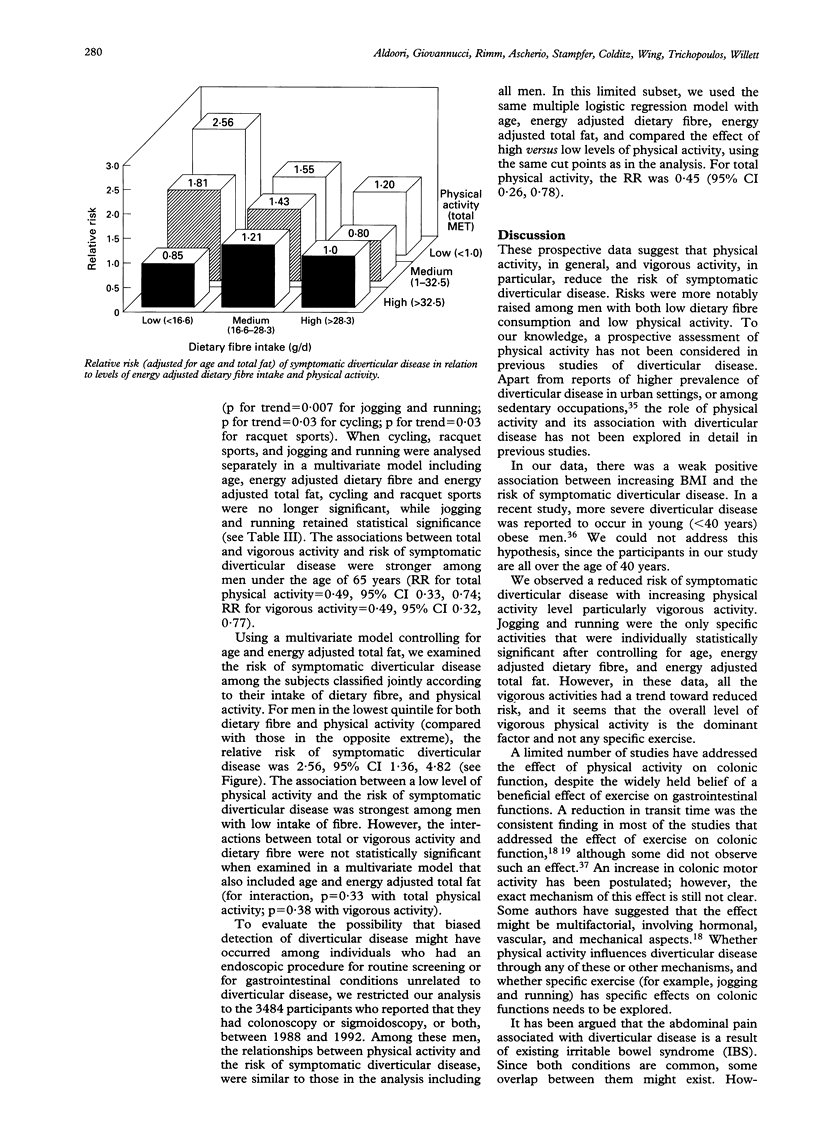
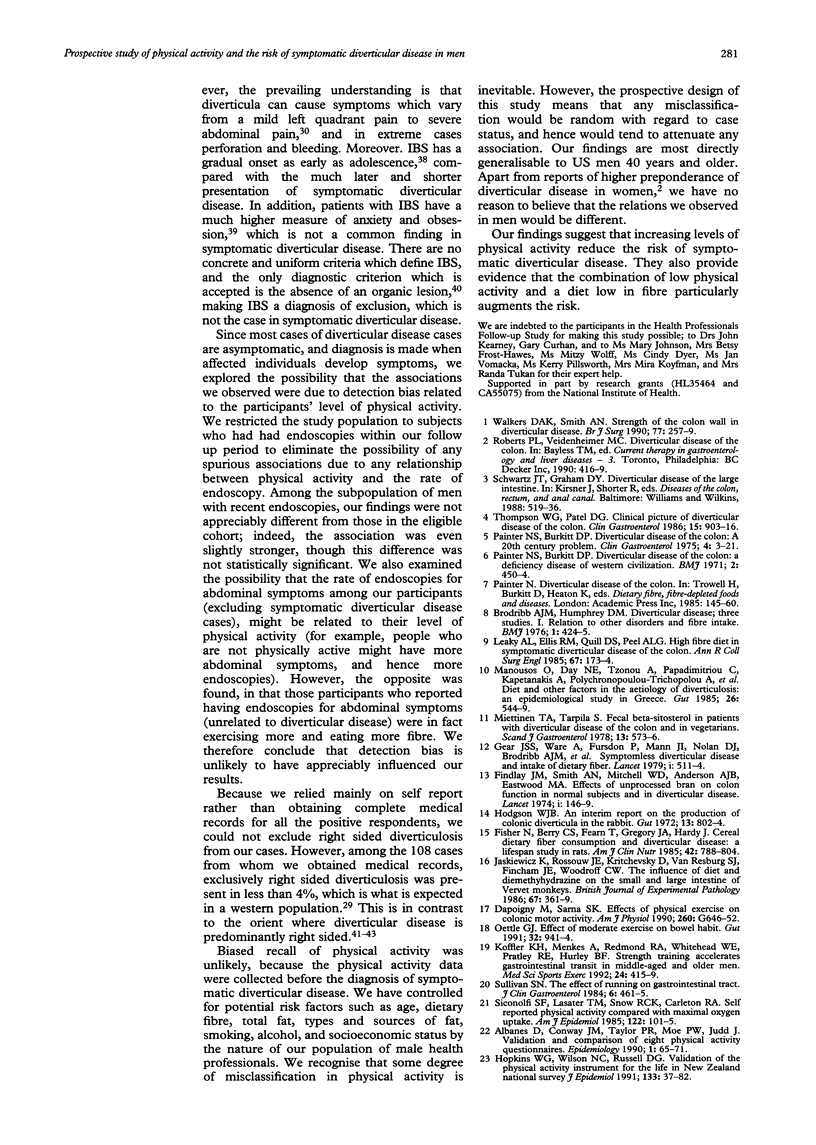

Selected References
These references are in PubMed. This may not be the complete list of references from this article.
- Ainsworth B. E., Haskell W. L., Leon A. S., Jacobs D. R., Jr, Montoye H. J., Sallis J. F., Paffenbarger R. S., Jr Compendium of physical activities: classification of energy costs of human physical activities. Med Sci Sports Exerc. 1993 Jan;25(1):71–80. doi: 10.1249/00005768-199301000-00011. [DOI] [PubMed] [Google Scholar]
- Albanes D., Conway J. M., Taylor P. R., Moe P. W., Judd J. Validation and comparison of eight physical activity questionnaires. Epidemiology. 1990 Jan;1(1):65–71. doi: 10.1097/00001648-199001000-00014. [DOI] [PubMed] [Google Scholar]
- Bingham S. A., Cummings J. H. Effect of exercise and physical fitness on large intestinal function. Gastroenterology. 1989 Dec;97(6):1389–1399. doi: 10.1016/0016-5085(89)90381-8. [DOI] [PubMed] [Google Scholar]
- Brodribb A. J., Humphreys D. M. Diverticular disease: three studies. Part I--Relation to other disorders and fibre intake. Br Med J. 1976 Feb 21;1(6007):424–425. doi: 10.1136/bmj.1.6007.424. [DOI] [PMC free article] [PubMed] [Google Scholar]
- Chia J. G., Wilde C. C., Ngoi S. S., Goh P. M., Ong C. L. Trends of diverticular disease of the large bowel in a newly developed country. Dis Colon Rectum. 1991 Jun;34(6):498–501. doi: 10.1007/BF02049937. [DOI] [PubMed] [Google Scholar]
- Christensen J. Pathophysiology of the irritable bowel syndrome. Lancet. 1992 Dec 12;340(8833):1444–1447. doi: 10.1016/0140-6736(92)92631-o. [DOI] [PubMed] [Google Scholar]
- Dapoigny M., Sarna S. K. Effects of physical exercise on colonic motor activity. Am J Physiol. 1991 Apr;260(4 Pt 1):G646–G652. doi: 10.1152/ajpgi.1991.260.4.G646. [DOI] [PubMed] [Google Scholar]
- Findlay J. M., Smith A. N., Mitchell W. D., Anderson A. J., Eastwood M. A. Effects of unprocessed bran on colon function in normal subjects and in diverticular disease. Lancet. 1974 Feb 2;1(7849):146–149. doi: 10.1016/s0140-6736(74)92439-8. [DOI] [PubMed] [Google Scholar]
- Fisher N., Berry C. S., Fearn T., Gregory J. A., Hardy J. Cereal dietary fiber consumption and diverticular disease: a lifespan study in rats. Am J Clin Nutr. 1985 Nov;42(5):788–804. doi: 10.1093/ajcn/42.5.788. [DOI] [PubMed] [Google Scholar]
- Gear J. S., Ware A., Fursdon P., Mann J. I., Nolan D. J., Brodribb A. J., Vessey M. P. Symptomless diverticular disease and intake of dietary fibre. Lancet. 1979 Mar 10;1(8115):511–514. doi: 10.1016/s0140-6736(79)90942-5. [DOI] [PubMed] [Google Scholar]
- Gortmaker S. L., Dietz W. H., Jr, Cheung L. W. Inactivity, diet, and the fattening of America. J Am Diet Assoc. 1990 Sep;90(9):1247-52, 1255. [PubMed] [Google Scholar]
- Hodgson W. J. An interim report on the production of colonic diverticula in the rabbit. Gut. 1972 Oct;13(10):802–804. [PMC free article] [PubMed] [Google Scholar]
- Jaskiewicz K., Rossouw J. E., Kritchevsky D., van Rensburg S. J., Fincham J. E., Woodroof C. W. The influence of diet and dimethylhydrazine on the small and large intestine of vervet monkeys. Br J Exp Pathol. 1986 Jun;67(3):361–369. [PMC free article] [PubMed] [Google Scholar]
- Koffler K. H., Menkes A., Redmond R. A., Whitehead W. E., Pratley R. E., Hurley B. F. Strength training accelerates gastrointestinal transit in middle-aged and older men. Med Sci Sports Exerc. 1992 Apr;24(4):415–419. [PubMed] [Google Scholar]
- Kumar D., Pfeffer J., Wingate D. L. Role of psychological factors in the irritable bowel syndrome. Digestion. 1990;45(2):80–87. doi: 10.1159/000200227. [DOI] [PubMed] [Google Scholar]
- Leahy A. L., Ellis R. M., Quill D. S., Peel A. L. High fibre diet in symptomatic diverticular disease of the colon. Ann R Coll Surg Engl. 1985 May;67(3):173–174. [PMC free article] [PubMed] [Google Scholar]
- Lee Y. S. Diverticular disease of the large bowel in Singapore. An autopsy survey. Dis Colon Rectum. 1986 May;29(5):330–335. doi: 10.1007/BF02554125. [DOI] [PubMed] [Google Scholar]
- Manousos O. N., Vrachliotis G., Papaevangelou G., Detorakis E., Doritis P., Stergiou L., Merikas G. Relation of diverticulosis of the colon to environmental factors in Greece. Am J Dig Dis. 1973 Mar;18(3):174–176. doi: 10.1007/BF01071969. [DOI] [PubMed] [Google Scholar]
- Manousos O., Day N. E., Tzonou A., Papadimitriou C., Kapetanakis A., Polychronopoulou-Trichopoulou A., Trichopoulos D. Diet and other factors in the aetiology of diverticulosis: an epidemiological study in Greece. Gut. 1985 Jun;26(6):544–549. doi: 10.1136/gut.26.6.544. [DOI] [PMC free article] [PubMed] [Google Scholar]
- Miettinen O. Estimability and estimation in case-referent studies. Am J Epidemiol. 1976 Feb;103(2):226–235. doi: 10.1093/oxfordjournals.aje.a112220. [DOI] [PubMed] [Google Scholar]
- Miettinen T. A., Tarpila S. Fecal beta-sitosterol in patients with diverticular disease of the colon and in vegetarians. Scand J Gastroenterol. 1978;13(5):573–576. doi: 10.3109/00365527809181766. [DOI] [PubMed] [Google Scholar]
- Oettlé G. J. Effect of moderate exercise on bowel habit. Gut. 1991 Aug;32(8):941–944. doi: 10.1136/gut.32.8.941. [DOI] [PMC free article] [PubMed] [Google Scholar]
- Painter N. S., Burkitt D. P. Diverticular disease of the colon, a 20th century problem. Clin Gastroenterol. 1975 Jan;4(1):3–21. [PubMed] [Google Scholar]
- Painter N. S., Burkitt D. P. Diverticular disease of the colon: a deficiency disease of Western civilization. Br Med J. 1971 May 22;2(5759):450–454. doi: 10.1136/bmj.2.5759.450. [DOI] [PMC free article] [PubMed] [Google Scholar]
- Painter N. S. The cause of diverticular disease of the colon, its symptoms and its complications. Review and hypothesis. J R Coll Surg Edinb. 1985 Apr;30(2):118–122. [PubMed] [Google Scholar]
- Parks T. G. Natural history of diverticular disease of the colon. A review of 521 cases. Br Med J. 1969 Dec 13;4(5684):639–642. doi: 10.1136/bmj.4.5684.639. [DOI] [PMC free article] [PubMed] [Google Scholar]
- Rimm E. B., Giovannucci E. L., Stampfer M. J., Colditz G. A., Litin L. B., Willett W. C. Reproducibility and validity of an expanded self-administered semiquantitative food frequency questionnaire among male health professionals. Am J Epidemiol. 1992 May 15;135(10):1114–1136. doi: 10.1093/oxfordjournals.aje.a116211. [DOI] [PubMed] [Google Scholar]
- Schauer P. R., Ramos R., Ghiatas A. A., Sirinek K. R. Virulent diverticular disease in young obese men. Am J Surg. 1992 Nov;164(5):443–448. doi: 10.1016/s0002-9610(05)81177-8. [DOI] [PubMed] [Google Scholar]
- Siconolfi S. F., Lasater T. M., Snow R. C., Carleton R. A. Self-reported physical activity compared with maximal oxygen uptake. Am J Epidemiol. 1985 Jul;122(1):101–105. doi: 10.1093/oxfordjournals.aje.a114068. [DOI] [PubMed] [Google Scholar]
- Southgate D. A., Bailey B., Collinson E., Walker A. F. A guide to calculating intakes of dietary fibre. J Hum Nutr. 1976 Oct;30(5):303–313. doi: 10.3109/09637487609144013. [DOI] [PubMed] [Google Scholar]
- Sullivan S. N. The effect of running on the gastrointestinal tract. J Clin Gastroenterol. 1984 Oct;6(5):461–465. doi: 10.1097/00004836-198410000-00013. [DOI] [PubMed] [Google Scholar]
- Thompson W. G., Patel D. G. Clinical picture of diverticular disease of the colon. Clin Gastroenterol. 1986 Oct;15(4):903–916. [PubMed] [Google Scholar]
- Vajrabukka T., Saksornchai K., Jimakorn P. Diverticular disease of the colon in a far-eastern community. Dis Colon Rectum. 1980 Apr;23(3):151–154. doi: 10.1007/BF02587617. [DOI] [PubMed] [Google Scholar]
- Watters D. A., Smith A. N. Strength of the colon wall in diverticular disease. Br J Surg. 1990 Mar;77(3):257–259. doi: 10.1002/bjs.1800770308. [DOI] [PubMed] [Google Scholar]
- Weber F. H., McCallum R. W. Clinical approaches to irritable bowel syndrome. Lancet. 1992 Dec 12;340(8833):1447–1452. doi: 10.1016/0140-6736(92)92632-p. [DOI] [PubMed] [Google Scholar]


